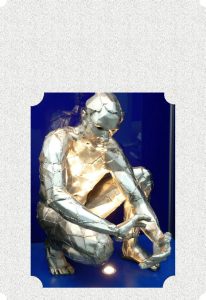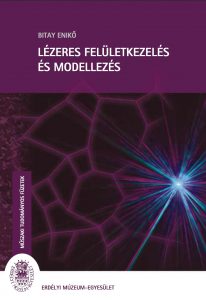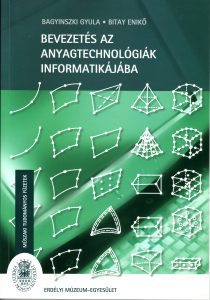Scientific books, lectures, notes, laboratory auxiliaries
Scientific books
Surface Treatment by Laser and Process Modeling
The development of structural materials and their technologies was conducted in the later years on existing theoretical and practical knowledge but nevertheless mostly on a basis of trial and error. The task of the not-so-distant future will be to develop procedures (simulation techniques) by means of which we will be capable to determine the structure of a given material by specifying the settings of a parameter of technology (e.g. surface treatment with laser) without having to resort to costly experiments of great volume.
By presenting the theoretical and practical side of technologies pertaining to surface treatment by laser, also their simulation techniques and complex mathematical side, this volume wishes to contribute to this task.
The entire content can be accessed here: http://eda.eme.ro/handle/10598/8923.
Introduction to the Informatics of Material Technologies
Besides construction measurements and design, choosing materials and corresponding technological planning are basic tasks of engineering work. Nowadays these too cannot be performed without the use of appropriate databases and software. In order to understand these correctly and implement them effectively we need such background knowledge in material technologies that refer to available and appropriate materials, their characteristics, also ways to conduct analysis that can quantify these, numeric methods, production procedures, characteristics of processes and their description.
This book deals with the summary and detailing of these topics from an informatician point of view.
The entire content can be accessed here: http://eda.eme.ro/handle/10598/8942.
Surface Treatment
By surface treatment we can create surface layers, crusts that can increase resistance to damage (to abrasion, tempering, corrosion, oxidation and fatigue) on otherwise – in lack of other requirements or demands – cheaper materials (work pieces) that are tougher and easier to process. Certain regions of the work pieces can be adjusted to specific local needs without significant changes in structure and characteristics in the greater part of their volume.
Besides presenting different surface treatment procedures based on different principles, this book also deals with those forms of damage that can require such treatments, some important characteristics of material surfaces, the methods by which a surface can be prepared and also with analysis pertaining to the qualifying of surfaces.
The entire content can be accessed here: http://eda.eme.ro/handle/10598/15436.
Welding Techniques I. Procedures and Mechanizing
Welding is the most important joining technology, a fact that is reflected also in the great variety of different procedures, the wide array of filler- and auxiliary materials that have been developed accordingly and also in the many possibilites for mechanization.
These together form a basis of welding techniques that can serve both the builder, the technologist and the manager. In order to contribute to a proper foundation for the building work this book provides a systematic and concise view on the aforementioned topics. It’s aim is to summarize such theoretical and practical knowledge that can support and develop the background knowledge of all those who have some connection with welding.
It tries to present to its readers in a compact yet encyclopedic form information about specific fields concerning welding, related procedures and possibilities for mechanization – that can simply be called technical background.
The entire content can be accessed here: http://eda.eme.ro/handle/10598/15437.
Welding Techniques II. Equipment and Measurements.
Electric welding equipment are the fundamental condition of their pertaining welding procedures therefore knowledge of their basic principle, build and workings is important. Furthermore, in order to effectively use the possibilities of these equipment it is recommended that we are aware of their functional characteristics: possibilities for settings and intervention, limits, effects on the working environment. According to this we also have to pay attention to related measurements, solutions for techniques of control, while not forgetting about the dangers that come with the use of electricity and ways to prevent them.
This book focuses mostly on arc welding and resistance welding, the principial and practical background and working characteristics of applicable equipment and tools, also with related measurement, control and safety issues. It wishes to provide a survey of the aforementioned specific fields of welding without claiming to be exhaustive but with the aim to support and develop the background knowledge of all those who have some connection with welding.
It tries to present to its readers information about specific fields concerning welding – equipment and their pertaining measurement, control and safety issues – that are simply part of the background in welding techniques – in a concise way and focusing on the essentials.
The entire content can be accessed here: http://eda.eme.ro/handle/10598/15438.
Laboratory auxiliary
Material Science Laboratory I. Investigations to Establish Properties of Materials
The teaching of the Science of Materials is an important section of any university or college level technical education. Practical work in the lab or in the classroom allows the students to become more familiar with the structural materials presented during the courses.
During these lab practices it is recommendable that one focuses on the components of these materials, their structure, available choices, the physical characteristics that serve as a foundation for construction planning, the options for technological processing and also their resistance to damage while in use and the possibilities and methods that allow the measuring, quantifying and controlling these – in other words the qualifying of materials.
This educationally oriented book – as a first volume in a series about laboratories in Science of Materials – is concerned with analysis that qualify the characteristics of structural materials and related mathematical problems. A special attention is given to the methods by which one can determine the standardized characteristics of materials – solidity, hardness, impact test – also the fundamentals of fracture mechanisms, and the mathematical analysis of dislocation and fatigue. Additionally the simple solutions for material identification are also presented.
Lecture notes
The Metallurgical Fundamentals of Welding, Soldering and Thermal Cutting (lecture notes)
 Forge welding is a manufacturing process that is almost as old as the use of iron itself (“iron age”) and up until the middle of the 19th century it was the only technique that could join together metals in a non-disassemblable way. The quick and spectacular development of material technologies and among them that of welding occurred in the 19th and 20th century a fact explained by the discovery of electricity, its means and its widespread use.
Forge welding is a manufacturing process that is almost as old as the use of iron itself (“iron age”) and up until the middle of the 19th century it was the only technique that could join together metals in a non-disassemblable way. The quick and spectacular development of material technologies and among them that of welding occurred in the 19th and 20th century a fact explained by the discovery of electricity, its means and its widespread use.
Welding in the industry is the most important technology for joining metals together, a fact reflected in the great number of procedure versions, the wide variety of auxiliary materials developed for them and the many possibilities of mechanizing and automation.
The aim of this booklet is to aid – by presenting the fundamental processes of welding – the absorption of knowledge in the field of Metallurgy and to stir interest towards a more profound study of the field of engineering in material technologies which is one of the most exciting directions within machine engineering.
The entire content can be accessed here: https://hu.scribd.com/doc/229730688/FemekTechnologiaja-Hegesztes#scribd.
The description of taught courses, lectures, laboratories (continually uploaded as it follows the curriculum – 1st semester)
Taught courses
- Engineering Material Science I. – Mechatronics majors and Mechanical engineering majors, 1st year
- Engineering Material Science II. (Engineering Material Technologies) – Mechatronics majors and Mechanical engineering majors, 2nd year
- Modern Material Science – Mechatronics majors and Mechanical engineering majors 4th year
- Fundamentals of Mechanical Engineering – Automatization and applied informatics majors – 1st year.





